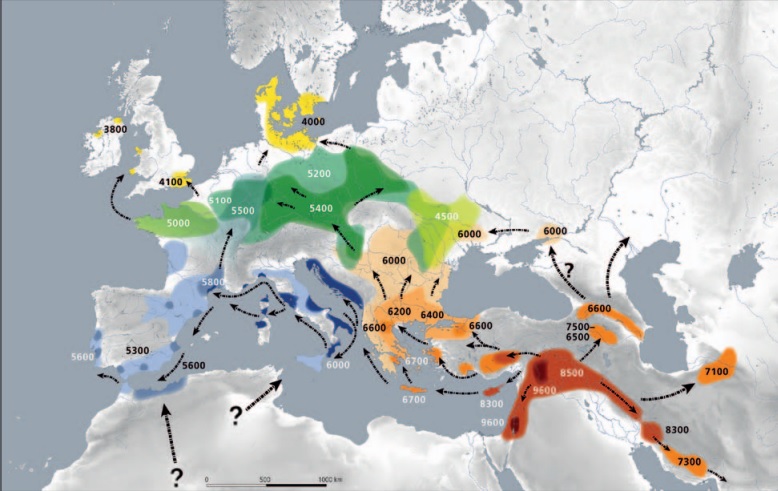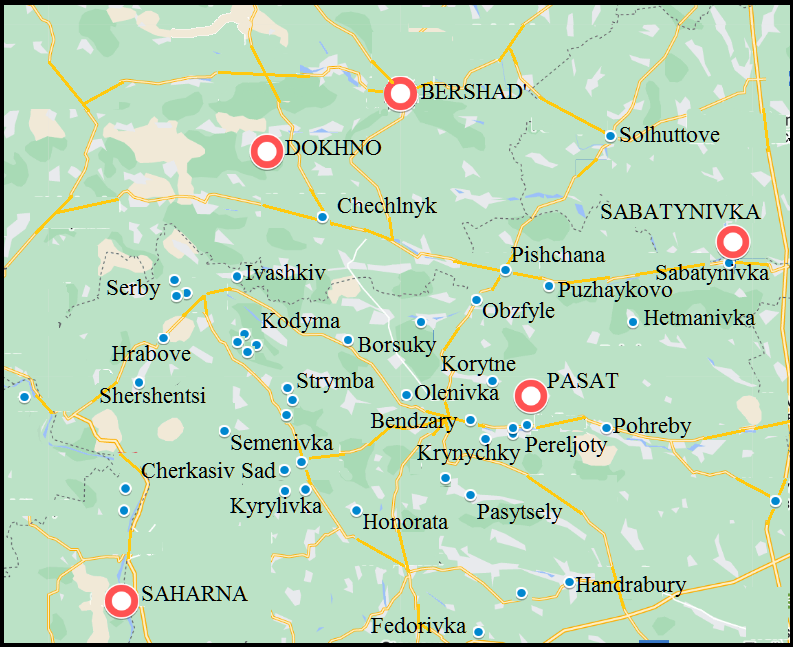An Unknown Semitic Tribe in Ancient Europe History
I consider it my duty to express my sincere gratitude to the professor of Germanic and theoretical linguistics at the University of Munich, Theo Vennemann, who kindly agreed to read the material of this article and refrained from critical remarks, but clarified the quoted passage from one of his works. At the same time, I would like to thank Professor Peter Reijke for the opportunity to familiarize myself with the work and for providing Theo Fennemann's address.
In principle, the future is determined by the past. It seems that the history of five years ago has a negligible influence on our future. Our ideas about antiquity have a significant influence on it. From this point of view, the study of the history of the Trypillians will have practical value if its ethnic basis ceases to be mysterious. And then we will be able to speak more objectively about how much the distant past influenced the nature of subsequent historical events.
The question about the origin and the ethnical belonging of the famous Trypilla (Tripolje) culture is dark up to this time. However, the concept of its autochthonous origin generally prevailed among its researchers for a long time. This Chalcolithic (Eneolithic) culture existed in Right-bank Ukraine and Moldova during the V-III mill. B.C. and left numerous archaeological sites with rich archaeological material, which allows us to recreate the look of Trypillians.
Trypillian culture is closely connected with the culture of Cucuteni in Romania; therefore, they are collectively called Trypilla-Cucuteni culture. One can say that the origin of these cultures is in Asia Minor. The impressive successes of paleogenetic research in recent decades have enriched our knowledge of human cultural evolution since ancient times. In this regard, the works devoted to human economic activity and especially the development and spread of agriculture (SHENNAN STEPHEN. 2018, KRAUSE JOHANNES mit TRAPPE THOMAS. 2019) deserve attention. Both works claim that the spread of agriculture to Europe came from the territory of modern Turkey, i.e., Anatolia. This idea finds interpretation in the works of other scientists, as evidenced by the map of the spread of agriculture from the Middle East to Western Europe (see below).
Fig. 7.The spread of agriculture in Western Eurasia
The Linearbandkeramik is shown in green (image by D. GRONEN- BORN / B. HOREJS / M. BöRNER / M. OBER 2019 [RGZM/OREA], Creative Commons Attribution 4.0 International License) [HOFMANN DANIELA, PEETERS HANS and MEYER ANN-KATRIN. 2022: 287, Fig 3].
The map shows that the practice of agriculture came to the area of distribution of the Trypilla-Cucuteni culture through the Balkans from Anatolia. In such a way, the creators of this culture could be Semites. This statement is substantiated in the article "The Real Cradle of Civilization" and here we will look for confirmation of it.

Left: The map of the migrations of the creators of Prekukuteni – Early Tripoli culture on the territory of Ukraine
The original of the map [ZALIZNIAK L.L. (Ed). 2005: 108. Fig. 1] was colored by the author].
Legend: I – the settlements of formative phase, II – the settlements of the type Larga-Jijia – Floreşti – Bernashivka, III – settlements between the Dniester and Bug Rivers and on Bug, IV – the first stage of migration, V – the second stage of the migration.
Settlements: 1. Sfântu Gheorghe; 2 – Eresteghin; 3 – Bancu; 4- Borlești; 5 – Traian; 6 – Izvoare; 7 – Ghigoiești -Trudești; 8 – Iași; 9 – Larga-Jijia; 10 – Vlădeni; 11 – Țigănași; 12 – Chetriș; 13 – Stolniceni; 14 – Fundurii; 15 – Bernashivka; 16 – Florești; 17 – Rogojeni; 18 – Haivoron; 19 – Sabatynivka; 20 – Vishnopil; 21 – Kostyantinivka; 22 – Oleksandrivka (according V.G. Zbenovich).
Culture Trypilla-Cucuteni existed on the territory of Right-Bank Ukraine and Moldova in the VI-III millennium BC and left behind numerous archaeological sites with a rich craniological material, which allows reproducing of the appearance of the Trypillians.
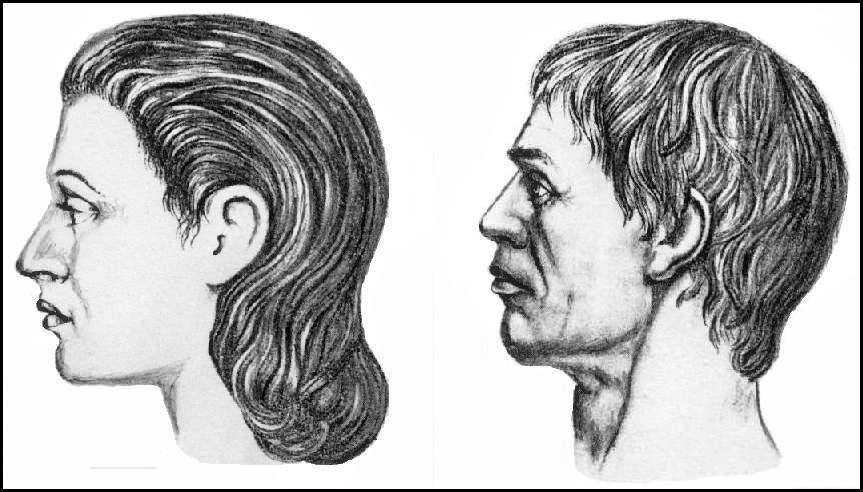
At left: Appearance of the Population of the Trypilla Culture.
A Trypillian woman and man Mediterranean anthropological type from the Vykhvatyntsi tomb. The burial place 35 and 19.
Reconstruction of M. M. Gerasimov on found craniums. (From the book "The Eneolithicum of the USSR").
Considering the contacts between Indo-European and Türkic languages we supposed that a mediator in these contacts could be the language of the population of Trypilla culture, occupying an area adjacent to the settlements of the Turkic people and Indo-Europeans but standing on a higher level of development than these (STETSYUK VALENTYN, 1998, 59). Recent studies conducted by Ukrainian archaeologists together with British colleagues by modern precision geomagnetic methods showed that the Trypillain population was organized in communities living in large settlements sometimes by more than 10 thousand men (RASSMANN KNUT a.o. 2014, 97-133). If there were in Ukraine more than two thousand sites of Trypillian culture with an area from 0.5 to 400 ha (BURDO N.B., POLISHCHUK L.Yu. 2013: 45), then the total population of its territory had counted up several million The density of Trypillia settlements attracted the attention of archaeologists shortly after the start of research:
In the area of Tripillia in the middle of the Dnieper, the area better explored by archaeologists, it was found that the settlements were located at a distance of about half a kilometer from each other. Suppose you put the discovered points of the Trypillia settlements on a map and compare this archaeological map with a map of the modern population of this area. In that case, it turns out that peculiar and completely, at first glance, the unexpected fact that there were more settlements in the 3rd millennium than now. They were located closer to each other than in our time. They were smaller than the current ones but were far more common. (PETROV V. 1947: 3).
After careful calculations, it may turn out that the current estimates may be too small. Such a mass of people could not disappear without a trace and must have had a great cultural impact on the newly arrived population. Such a mass of people must have had a great cultural influence on the newly arrived population.
 |
Reconstruction of the Trypillian settlements
At left: The village of Maidanetske in Cherkasy Region.
Reconstruction of the Trypillian site in the Maidanetske local museum from 1998.
The houses are placed in a forested environment. The picture from the local museum from 1998. Photo: Johannes Müller, Kiel. (RASSMANN KNUT a.o. 2014: 118)
At right: The Aleksandrovka settlement according to excavation data
v. Kyrylivka, Kodyma district of Odesa Region.
(BRUYAKO I.V., SAMOYLOVA T.L. (Ed.). 2013: Table 1).
According to many experts, just as our research, the Trypillians were not Indo-Europeans, nor the Turkic people, and at the same time their ancestors came from Asia Minor (see the section "The First Neolithic Tribes in Eastern Europe "), so the assumption was made possible linguistic identity Trypillians to the Afro-Asiatic family. The existence of Tripoli culture coincides in time with Seredniy and Pit (Yamna) Culture, which occupies an area between the lower Dnieper and Don Rivers. Their creators were ancient Turkic people (more on this in the section "Ethnicity of the Neolithic and Eneolithic cultures of Eastern Europe".) At the turn of the 4th and 3rd millennia BC, some Turkic tribes began to migrate en masse to the right bank of the Dnieper, as evidenced by archaeological finds with clear signs of the Yamna culture. Even though the Trypillians were at a high level of development at that time and exerted a certain ideological influence on their neighbors, the Turkic people gave rise to new European cultural traditions. They brought with them the image of a bull and a phallic cult as symbols of male power and, as a consequence, a patriarchal and clan system: as well as a cult of ancestors and a burial rite (ALEKSEYEVA I.L. 1991, 20-21). At the same time, the anthropological study of archaeological sites of the North-Western Black Sea region gives grounds to speak about the process of interbreeding and mutual assimilation of the Trypillian population and settlers from the left bank of the Dnieper. (ALEKSEYEVA I.L. 1978: 56). Additional information about the Trypillians can be found in the section The First Great Migration".
G. Child wrote about the possibility of forming the peculiarities of the sites of the Usatove type based on the Trypillian culture under the domination of foreign chiefs-cattle breeders. Currently, his hypothesis finds followers [PETRENKO V.G. 2013: 208]. David Anthony also belongs to them. Having analyzed the materials of Odessa archaeologists about the economy, ceramics, burials of the Usatovo settlements, and the neighboring Yamnaya culture, he came to the following conclusion:
The people who founded the Usatove settlement probably were descended from an earlier generation of steppe herders who had lived in the Dniester and South Bug steppes, not from Tripolye farmers who had lived in the uplands. [ANTHONY DAVID W. 2008, 36].
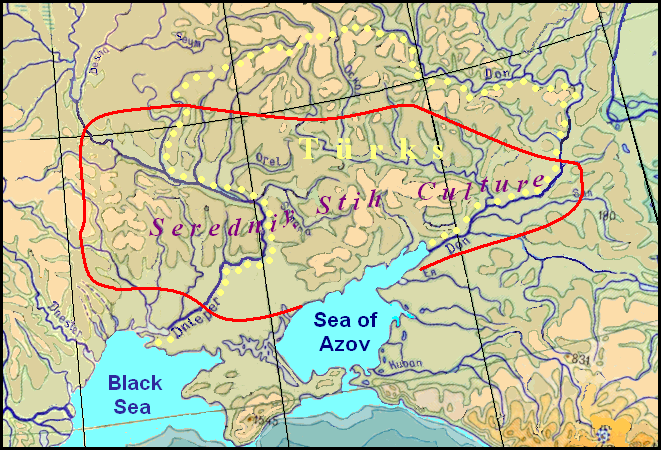
At right: The original territory of the Turkic tribed is the area between the Dnieper and Don Rivers (indicated by yellow dots) and the dissemination area of Seredniy Stih culture (limited by the red line).
The areas of the settlements of the Turkic people and the Seredniy Stih culture, from which the Yamnaya developed, basically coincide and the continuity of these cultures has no objections and this continuity can also be traced in the Corded Ware culture (CWC). The spread of the Seredniy Stih culture over a fairly large area of Right-Bank Ukraine may indicate the beginning of the push of the Turkic tribes as carriers of the CWC over the vast expanse of Europe.
The numerous Trypillian populations could not disappear without a trace, so it can be assumed that the Trypillians were involved in the mass migration process of the Turkic tribes. According to archaeologists' calculations, the number of the Trypillian population, who survived the invasion of nomads, decreased three to four times [VIDEIKO MYKHAILO. 2011: 379], which may testify in favor of such an assumption. The typical Trypillian painted utensils, which can be found in the assemblages of corded ceramics (PETROV V. 1947: 35), betray the presence of Trypillians among the "Cordians". The Turkic people themselves, as nomads, were not so numerous as to settle in the vast expanse of Europe, where traces of the CWC were found.
Trypillians: An elderly man of Caucasoid type and a girl of Mediterranean anthropological type.
Burials in the settlement of Nezvisko III and from the Vykhvatyntsi tomb 5 respectively. Graphic reconstruction by M.M. Gerasimov on found craniums. (From the book "The Eneolithicum of the USSR").
The mixed composition of the Right Bank population is confirmed by finds of skulls of different anthropological types found among Trypillian burials (see the figures above). Dwelling among farmers, Turkic pastoralists acted as an ethnic class and a specific xenocratic (from the gr. ξένος “stranger”, “guest”, “master” and κράτος “strength”, “power”) political system . Figuratively speaking, they represented something like a "superstructure" over the settled agricultural “base” (KRADIN N.N. 1999, quoted from KRADIN N.N. 2007: 27-28). Thus, the Turkic people established a xenocracy regime over the Trypillians, imposing their way of life and language on them, as evidenced by numerous toponyms of Turkic origin in Central and Northern Europe. Linguistic expansion is different. How the assimilation of the language of the conquerors by the autochthonous population takes place was described by the American anthropologist as follows:
Military conquest, another vector of language expansion, carries the language of the conquerors only when it provides the defeated access to the new prestige system at a relatively low social cost—in other words when there is both little negative shame or humiliation for a person’s family if that person cooperates with the conqueror, and widespread positive public recognition or reward for most who cooperate, including the opportunity for their children to advance to higher social positions [ANTHONY DAVID W. 2008: 3].
While the latest arrivals of Indo-European origin assimilated most of the Turkic people who settled throughout Europe, one Turkic tribe escaped such a fate and its descendants dwell to this day, they are the modern Chuvashes. Their ancestors, whom we will call the Proto-Chuvashes, settled in Western Ukraine and lived there for a long time, at the beginning of the first millennium AD they migrated to the Black Sea steppes and became known as the Scythians. Later, part of them went to the Middle Volga, and the other – to the Balkans. The assumption about the Semitic affiliation of the Trypillians can be confirmed by the presence of Semito-Hamitic roots in the Chuvash language. In addition to the Turkic people, the Trypillians also neighbored some Indo-European tribes, which could also be reflected in their language. Purposeful searches for lexical correspondences between Semitic, on the one hand, and Indo-European and Turkic, on the other, have provided some material to speak more confidently about the Semitic origin of the Trypillians. This idea is not new and has already been expressed earlier by some researchers, whose works the author is not familiar with, but only knows about from newspaper publications.
A fantastic idea of the Sumerian roots of the Chuvash people is widespread among them now. It was formed largely by G. Yegorov. There are in his book (YEGOROV GENADIY, 1993) many dubious and far-fetched facts. Still, he had grounds for such assumptions in some parallels between the Chuvash and Middle Eastern languages and myths, which displayed the Proto-Chuvash-Trypillya cultural connections.
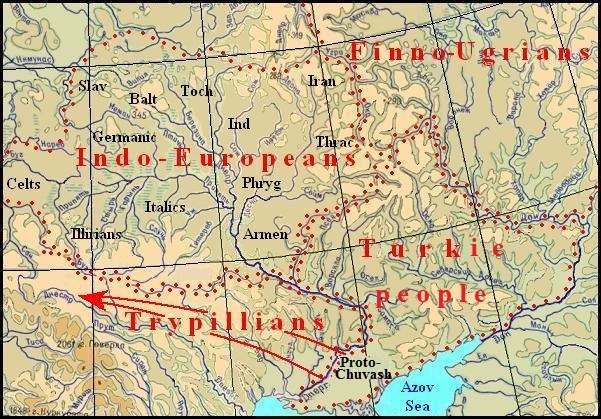
Some Turkic words, including Chuvash having correspondences in the Semitic languages can be attributed to the common stock of the Nostratic languages. For example, the Turkic word adam “a man” ot Tat., Uzb., Kytg., etc arča “pine-tree” corresponding Ar. erze, Hebr. arez “cedar” a.o. Significantly more words of Semitic origin were borrowed in the Turkic languages out of Arabic in the process of Islamization. There are some in the Chuvash. For example, Ar maskara “mockery” – Chuv myskara “amusement”, Ar miškin “miserable” – Chuv měskěn “lamentable”, Ar šabaka “net” – Chuv sapaka “cluster”.
However, the Islamization of the population of the Middle Volga, which began with 922, did not cover the Chuvash in the mass. According to Ibn Fadlan, only the top of the Chuvash people passed to Islam – feudal nobility, merchants, and townspeople (SKVORTSOV M.I., 1995: 14). Therefore, many Arabic words could penetrate the Chuvash language via Tatar. At the same time, some borrowings from Arabic are very old and belong to the sphere of pagan beliefs. For example, the Chuvash mythology has a god of abundance Pereket tour (out of Ar. baraka "grace"). The question arises as to why the pagans have borrowed the name of one of their gods from the Arabs, Muslims, alien to the masses. And there is a lot of such borrowings. R.G. Akhmetiyanov writes:
… the Chuvash language has a lot of Arab-Persian words that do not occur or are not active in the modern Tatar dialects or differ sharply from the Tatar-sounding parallels. Chuvash researchers believe their own words, borrowed in the ancient Bulgars period, ie not directly connected to the influence of Tartar (AKHMETIYANOV R.G., 1978: 121).
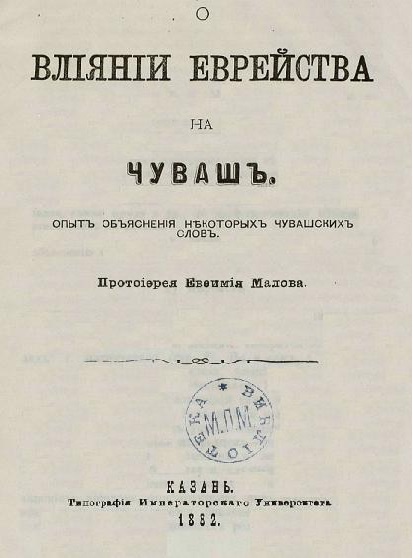
This author calls the Proto-Chuvashi Bulgars, but in fact, such a people never existed, and this was the name of the ruling elite of the state on the Middle Volga, which received its name from this word (see Volga Bulgars). The bibliography of the book cited includes the work of Archpriest Evfimy Malov "On the Influence of Jewry on the Chuvashe" (MALOV E. 1882). I didn't have a chance to get acquainted with this book, but the title speaks for itself.
Left: Title page of Malov's book. The book can be downloaded from the website RUKONT for 90 Rubles.
Thus, in the attempt made to find in the Chuvash language possible borrowing from the Semitic, which retained analogs in both Arabic and ancient Hebrew, attention was drawn to the presence of these same roots in Indo-European. In particular, there is reason to talk about cultural and linguistic relations between the Semites and the Germans:
Ancient Germania shows a number of striking similarities to the old Semitic world in language and culture.
Words such as Proto-Germanic *fulka "division of an army", *sibjo “extended family”, *aþal-l/aþili “noble (noun/adjective)”, *maguz/*magaþ(i)z “boy/girl”, which only occur in Germanic or at best in some neighboring languages and posses no generally accepted Indo-European derivation, have intriguing Semitic etymologies (VENNEMANN DOOR THEO, gen. NIERFELD, 2012, vıı-vııı)
Let us consider these words
1. Theo Vennemann compares Old Germanic *fulka (Eng folk, Ger. Volk) and also Eng. ploug, Germ. Pflug a.o. with Hebr plC, a family of related roots including plg, all meaning "to divide, separate" (VENNEMANN THEO, 2005, 27). The Semitic root has good matches in Chuvash: Pülĕkh "a distributor", "providence", Chuvash ancient deity and pulkkǎ "flock", "crowd"
2. Old Germanic *sibjō (Goth sibja, OE sibb, Ger Sippe "family", "kin", "clan" have a match in Chuv syp “generation”, sypă “knee” (as "generation" too)
3. Old Germanic *magaþi (Goth magaþ-s, OE mæged, Ger Magd "young woman", "girl" – cf. Chuv “măkka “endearment, usually to children”.
4. Old Germanic *aþal-l/aþili (OE æđel “noble”, Ger Adel "nobility") – cf. Chuv “atalan “to develop, grow”.
Thus, Semitic loan words in the Chuvash language gain weight when they have matches not only in Arabic and/or Hebrew but also in modern European languages. The search for such matches was done and by the way, a few words were found in the Ukrainian, Hungarian, and Romanian languages without proper etymology and having no matches in Chuvash, but they can be associated with the Semitic words. They were taken into consideration too. In such a way, a list of hypothetical Trypillian words was put. Of course, some parallels can look more or less doubtful but chance words can be thrown out always. It is better to consider a doubtful fact than to lose an interesting matter.
Tryp *afuna “pea, berry” [Hebr אֲפוּנָה (afuna) “pea”, Ar. حفنة (hafna) "bunch"] – Rom afîna “bilberries”, Ukr dial. afyny “bilberries”, Lat aveva “oat”, Tur, Uygur evin “seed”.
Tryp *arb “barley” [Hebr בָּר (bar) “corn”)] – Chuv urpa, common Turkic arpa “barley”, Alb. elb “barley” (Thrak *alb “barley”), Gr. αλφι “barley”.
Tryp *areh “spider” [Hebr ארוג (arug) “woven”, אֶרֶג (areg) “fabric, cloth”] – Chuv erešmen “spider”, Gr αραχνη “spider”, Lat araneus “spider”.
Tryp *aruz “rye” [Hebr אוֹרֶז (orez) “rice”, Ar. أرز arz “rice”] – Chuv. yraš, Kaz. arys and other similar Turkic “rye”, Rus. rož' and other similar Slavic "rye", Lit. rugys “rye”, OE. ryge, Ger. Roggen “rye”.
Tryp. *bayer “source” [Hebr. בְּאֵר (beer) “well, pit”), Ar. مدح (ma') "water", jura "pit" ? (RAJKI ANDRÁS. 2005)] – Ukr. bayura "deep puddle", "pit".
Tryp *balta “axe, hammer” [Ar. بلطة (balta) "axe", بلوط (balut) “oak”, Hebr פְּלָדָה (pelada) “steel”, בַּלוּט (balut) “acorn”] – complete similarity of the name of ax in the Turkic languages to Arabic one may imply a borrowing from Turkic to Arabic, but the etymology of the Turkic word has not been established and there is an assumption about the Assyro-Babylonian origin of this word (LEVITSKAYA L.S. et al. 2003: 108). In this regard, its Semitic origin should be recognized as well. First hammers could be made out of oak block with a bough used as a holder therefore the name of the hammer was similar to the name of oak. Later the name of the hammer was transferred to a stone or metal axe. The names of hammer, axe, and other tools or arms are based on similar roots in many languages of several language families: balt, bolt, molt, bart, palt, purt etc (wide-spread Turkic balta “axe, beetle, hammer”, Het malatti “weapon”, Gr παλτρον “lance”, Toch peret “axe”, Lat. martellum “large hammer”, bardicum “lance, small axe”, common Slavic moltъ “hammer”, Eng bolt, Germ Barte “small axe”, Bolzen “bolt”, Port balde “spade”, Osset färät “axe”, Chuv purtă 'an axe", Udm, Komi purt “a knife”, Hung bárd “axe” etc). It should be supposed that all these words descended from some Nostratic root, but they were abundant therefore they, permanently transferring from one language to another, became different forms and meanings.
Tryp *burg “cylinder, tower” [Ar برج (burǰ) “tower”, Hebr בֹּרֶג (borag) “a screw, bolt”] – Gr πυργοσ “tower”, Lat burgus “castle, tower”, Chuv purak “bast, bast-basket (cylindrical)”, Karach buruu “fence”, Germanic *burg (German Burg “castle”).
Tryp *fahar “white” [Hebr פַּחַר (fahar) “white clay”, בָּהִיר (bahir) "white", Ar. فخار (fahar)„pottery, porcelain”] – Hung feher “white”. The origin of the Hungarian word is undefined, but the possible connection with the Semitic languages is also unclear. We should consider its connection with the Kab. faghue "pale".
Tryp. *faida “benefit” [Hebr. פדיון (pidyon) "proceeds", "redemption", Ar. فائدة (faida)„benefit”] – Chuv. payta “benefit, gift”, Tel, Shor. payda "benefit". Many Turkic languages have this word, but it could be borrowed together with Islam. But the Chuvash, Teleuts, Shors, and other small peoples of Altai are not Muslims.
Tryp *farah “to fly” [Hebr. פֶּרַח (farah) “to flutter, fly about”, Ar. فراشة faraša "butterfly"] – Chuv părakh “to throw”.
Tryp *gaba, gabal “great body” [Hebr. גַב (gav) “hinter part of, spine”, Ar. كفل (kafal) “croupe”, جمل j’amal “camel”, Phoen gebal “mountain”]. – Wild horses inhabited the steppe of Ukraine in Herodotus’ time, but Trypillians domesticated them, and Turkic people horses together with the name from them (common Türkic jaby “horse”). Although Turkic languages have other, the own name of horse at. The word jaby was borrowed by Old Greeks (Gr ιπποσ “horse”) and by Finno-Ugrians (Veps hebo, Fin hepo, Est. hobu, Hung lova “horse”). Trypillian root gaval also gave the name of the horse which Indo-European borrowed from Trypillians without Türkic mediation (Lat caballus “horse”, Gr καβαλλησ “working horse”, Lit kumele “mare”, Sl kobyla “mare”, Pers kaval “swift-footed horse”). Chuv haval “force” can be referred to here.
Tryp *gavr, kaur “embers” [Ar جمر (ǰamr) “embers”, Hebr. כּוּר (kur) “furnace, melting pot, forge”] – Chuv kăvar “embers”.
Tryp *gaz “goose” [Ar وظ (vaz) "gooses", Hebr אַוָזָה (avaza) “goose”] – Tur, Turk gaz, Chuv hur , other Turkic “goose”.
Tryp *habak “some kind of grass-plant” [Ar حبق (habaq) bot. “basil”] – Chuv hupah “burdock”.
Tryp. *haman “faithful, reliable” [Hebr. אָמוֹן (amun), Ar. أمين (amin) “faithful”] – Chuv.haman “faithfulniss, solidity”.
Tryp *hom “father-in-law” [Hebr חָם (xham) “father-in-law”, Ar. حمو (hamu) "father-in-law"] – Chuv hun’ “father-in-law”.
Tryp *hota “to seek in marriage” [Ar xatan, Hebr חוֹתֵן (khoten) “father-in-law”] – Chuv xăta “father of son-, daughter-in-law”.
Tryp *huša “hut” (ар. huša “hut”)- Chuv xüšĕ “hut, cabin, light house” – Ger Haus, Eng house.
Tryp *kad “pot, barrel” [Ar kadah “goblet”, Hebr כַּד (kad) “pitcher”] – Ukr kad’ and other similar Slavic words “barrel”, Gr καδοσ “pitcher, jug, pail”, Alb kade “barrel”, Hung kád “barrel”.
Tryp *kart “village” [Phoen kirjat, Hebr קֶרֶת (keret) “town, city”] – Chuv karta “palisade”, Germanic *garda, gardon (Got gards “house”, Old Eng geard “yard”, German Garten “garden”). Similar words are present in Slavic, Celtic, Greek, Latin, and other Indo-European languages, but consonantism of these words contradicts the rules of Indo-European languages, therefore one can think that this word has been borrowed from some other language.
Tryp. *kemel “reward” [Hebr. גְמוּל (gemul) “reward”, Ar. كمال (kamal) “perfection”] – Chuv. kěměl “silver”, silver is called in other Turkic languages called kümüš in full compliance with the phonology of these languages. More detailed about a change of the meaning in the section Sketch on the Development of Merchandise in Eastern Europe at Prehistoric Times.
Tryp *keser “carrot” [Ar جزر (ǰazar), Hebr גֶזֶר (gezer) “carrot”]. This word was borrowed only by Western Türkic tribes which had closer contact with Trypillians: Chuv, Tat kišer, Turkm kešer “carrot”.
Tryp *kors “scone, bread” [Ar qursa “scone”] – Ukr, Blr korž “scone”, Fin kyrsä “bread”, Veps kürz “fritter, cake”, maybe Afg kulča “pastry, cookie, biscuit”. The words of this root are widrly-disseninated among various languages and have meanings “bread”, “corn”, “sheaf”, “millet”, “besom” etc: Arm xurdz, Kurd gurz, Osset kyris “sheaf”, Chuv kurăs “cluster of bast”, xuraç “food”, Komi korös’, Mansi kuras’ “besom”, Germ Hirse “millet”, Let garsa “gout-weed , Aegopodium podagraria ” (umbrella eatable plant), Rus (dialect) koros, korost “stack of flax sheafs”, Gr koros “satiation”, Let cers “bush”, Old Eng kors “reed, rush” (from Celtic). With the change r in l: Gr κολλιχ “round bread”, Hung köles “millet”, Let kulis “sheaf”, Slav kolsъ (Ukr, Rus kolos “ear”, Cz, Slov klas etc). Some names of gods can also be added here: Latin goddess of vegetation Ceres, East-Slavic god Khors. Maybe, Ukr koryst’ “use”, Osset xorz “good”, Rus khoroshy “good”, Germ Horst “bush-wood” are belonged to this root.
Tryp *lavh “board, plank” [Ar لوح (lavh) “board”, Hebr לוּחַ (luxa) “board, table”] – Slav lava, lavka “bench” (Ukr, Blr lavka, Pol ławka, Rus lava, Cz lava etc). Chuv lapka “shelf”, lav “cart”, (first carts were ordinary board on wheels).
Tryp *lis “thief” [Ar لص (lis) “thief”] – Slav lis, lisa “fox” (Ukr, Serb lys, Rus lisa, Pol lis, Sloven lis etc). The fox has the by-name “thief” in Slavic folklore.
Tryp *masa “to feel by touch” [Ar massa “to touch”, Hebr מישש (mišaš) “fingered”] – Chuv masa “exterior”, Ukr matsaty, Slovak macat “to feel by touch”.
Tryp *nur „light, fire, red” [Ar. نور (nur) „light”, Hebr. נור (nur "fire"] – Chuv. nar “ruddiness, roses”, "nice".
Tryp *peruti “fur, fell” [Hebr. פַּרוָתִי (peruti) “fur, fell”] – Chuv. pětrě “leathern sack”, Gmc. *fodra “fur, fell” (Ger. Futter “fur, fell”).
Tryp *rešet “net” [Ar, رشفة (rashfa) "sip, strain", Hebr רשת (rešet) “network”] – Slav rešeto (Ukr, Rus, Bulg, Serb, Slov rešeto etc “sieve, riddle”).
Tryp *sabon “soap” [Ar. صابون (sabun), Herb סַבּוֹן (sabon) "soap"] – Chuv. supăn, Lat sapo, sapōne, Eng soap, Ger Seife a.o. – all “soap”.
Tryp *sak “sack” [Ar. saki "wineskin", Hebr שַׂק (šak) “sack”] – Chuv šak “a fishing net, coop”, Lat saccus “sack”, Gr σακκοσ “sack”, Ukr, Rus sak “fishing-tackle in the form of sack” and other similar Slavic and Germanic words.
Tryp *sameh “glad, joyous” (Hebr שַׂמֵחַ (sameakh “happy, glad, joyous”) – Chuv savăk “joyful, gladness”.
Tryp *šap- “to strew” [Hebr שְׁפּוֹך (šofekh) “to spill, pour”] – Chuv sap “to strew, pour”, Slavik sypati (Ukr sypaty, Rus sypat’ , Cz sypati etc “to strew, pour”).
Tryp *šart “condition” [Ar. شرط (šart “condition”, Hebr שָרָת (sharat) "server"] – Chuv šǎrt “oath”.
Tryp *seret “strip, strap” [Ar شريط (šarit), סֶרֶט (seret) "ribbon, strip, belt"] – Chuv serete “plank”, Kurd sirat “way”, Rom., Ukr “Seret” (names of several rivers in Ukraine and Romania).
Tryp *tahal “spleen” [Ar طحال (taal), Hebr טְחוֹל (tehol) "spleen"] – Chuv, Tat and other talak, Yak taal, Khak tölön, tileen, “spleen”. The oldest Türkic form is presented in the Yakut language.
Tryp *taham “taste” [Hebr טַעַם (taam) “taste”, Ar ta’am “taste”] – Chuv těhěm “taste”.
Tryp *tavar “thing, the object of exchange” (Hebr דָבָר (davar) “word”, “thing”, “something”) – Chuv tăvar "salt", Ukr, Rus tovar “goods” and “cattle”, Arm tavar “sheep”, “flock”, Kum tuuar “flock”, Tur tavar “property”, “cattle”, Balk, Crim-Tat tu’ar “cattle” etc. Salt was the main export product for the Proto-Chuvashes, therefore, it became sense “goods” (STETSYUK VALENTYN, 1998: 57). Many Iranian languages have the words tabar-teber-tevir “axe”, but Finno-Ugrian words of this root have sense “textile” (Saam tavjar, Mar tuvyr, Chant tegar). All these things are objects of barter and trade, that is to say, goods.
Tryp *tiše “grass” [Hebr דֶשֶׁא (deše) “grass, sward, herbage”] – Chuv těšě “grain”, Mord tiše “grass, hay”.
Tryp *tora “unwritten law, customary” [Hebr תּוֹרָה (tora) “law”] – Chuv türe “judge”, Tat türä “law”, “judge”, Tur töre “customs” etc.
Tryp *vaita “cabin, house” [Ar بيت (beyt), Hebr בַּיִת (bait) “house”] – Chuv vite “cow-house”, Lat *baita “cabin, house”. Restored Latin word is present in some nowadays Italian dialects (MEYER-LÜBKE, 1992: 70).
Tryp *vakar “bull” or “cow” [Ar بقرة (bakara) “cow”, Hebr בָּקָר (bakar) “cattle”] – Chuv văkăr, Tur öküz, Tat ögüz etc “bull”, Lat vacca “cow”. Ukr dial. vakar “herdsman of cattle” – out of Romanian. The name of copper baqyr in the Turkic languages comes from the same Trypillian word.
Tryp *verah “flower” [Ar firh „branch”, Hebr פֶּרַח (perakh) “flower”] – Hung virág “flower”. This parallel entails a whole chain of thoughts. There is in Latin the word virga “twig, rod” having no correspondences in Indo-European but refers to Old Turkic bergä, “twig, birch, whip”, Xak, Uyg berge “whip”. Sir Gerard Clauson writes: “berge – a whip an old word ending in –ge. It is suggested.., that it is a loan-word from Latin virga ‘a rod, a stock’ obtained through Middle Persian but there does not seen to be any trace of the word in Persian, and the theory is importable.” The Hungarian virgácz “twig, birch” which borrowing from Latin is doubtful can be referred to them. In this case, Hung virgone “agile, nimble, lively” and Chuv virkěn “to race, rush” also correspond to these words. Obviously, it is a wandering word which traces are present in many languages having different but similar meaning (e.g. Erzya verka “quick”, Rus birka and other similar Slavic words “small twig”, “catkin”, Ger Birke “birch”, Kurd wurg “lively”). If the creators of the Tripilla culture were Semites, the all these words can have an origin word similar to the Ar firh and Heb. perax "flower". Then Lat virgō "virgin" of unknown origin (W.) should be referred here (cf. "deflowering").
Tryp *xarta "a piece of textile" [Hebr. חָרוֹת (kharut) "cutting"] – Chuv khărta "patch, clout", Gr χαρτησ, Lat carta "a paper, leaf".
Tryp *zivit “resin” [Hebr זֶפֶת (zefet) “tar, pitch, resin”, Ar zift, Syr zifta “resin”] – Arm jivt “resin”, Ukr zhyvyts’a and other similar Slavic words “galipot”, Ger. Saft "sap", Gift “poison”.
The Semitic origin of the Trypillians can be confirmed by the explanation of "dark" place names of Right-Bank Ukraine using Hebrew. As settlements of Trypillians numbered several thousand inhabitants, at least some of them must have existed for a long time and kept their original names. If it will be found a sufficient number of names interpreted in Hebrew, it would show not only the Semitic origin of the Trypillians but also mean that given by their names existed at least six thousand years.

At right: Place names of possible Semitic origin on the area of Trypillian culture.
To decipher the name of the village of Bakota now flooded by waters of the Dniester reservoir and the village of Bakoty of Kremenets district in Ternopil Region, Hebr. בִּקתָה (bikta, bekata) "hut, shack, shanty, shed" suits well.
Maybe Herb. בַּר (bar) "son, boy" and שֵׁד (shed) 1. "demon, the devil", 2. "imp" is hidden in the name of the town of Bershad of Vinnytsia Region. It is unlikely that the devil could be present in the name of the settlement, but the combination of "imp-boy" is very possible.
Deciphering the similar name of the Romanian city of Bârlad is more complicated. It is difficult to find an acceptable pair to the second part of the word that can be associated with Hebr. לָעַד (lada) "forever, eternally" even though the choice is great. Hebr. בִּירָה (bira) "sout" suits best by meaning.
The name of the village of Dokhno and flowing here the Dokhna River well corresponds Hebr. דוֹחַן (dokhan) "millet" according to the agricultural economy of Trypillians. The name of the grain, which was a commodity in the barter trade, could give names to other commodities in some languages, such as cattle and the like – Chech. daьkhny "property, cattle" (aь – a front vowel).
Convincing explanation of the origin of the name of the capital of Moldova Chisinau is absent. Phonetically and situational Hebr קָשֶׁה (kashe) "hard, harsh, tough" and עַנָב (anav) "grape"
A large Trypillian settlement was found on the bank of the Dniester River in the Chernivtsi Region on the outskirts of the village Moshanets. The name of the village can have Semitic origin: cf. Hebr. מוֹשָׁבָה (moshava) "colony, settlement, village, dominion".
The settlement of the early Trypillian culture is also located in the outskirts of the village of Sabatinovka in the Blagovischensk district of Kirovograd Region. The name is well understood with the help of Heb. שׁבּת (shabat) "Saturday".
Hebr. סֶרֶט – (seret) "ribbon, strip, belt" suits well for explanation the name the Seret River, the left tributary of the Dniester and the left tributary of the Danube.
Less likely is the Semitic origin of the name of the village Talianki of Cherkasy Region, near which found traces of a large Trypillian, numbering 2,100 housing units in the area studied by the geomagnetic method of 170 hectares (RASSMANN KNUT. 2014: 110). If you cannot find a more reliable interpretation, the name may be connected with Hebr. תִליוֹן (talion) "something hanging, a pendant, medallion".
There was a city of Tyras at the mouth of the Dniester River in ancient times. The city of Tira (טִירָה) exists in Israel. In Hebrew, the word טירה (Tira) means "castle". Of course, the Trypillians had no castles, but a fortified settlement could have such a name.
The names of other settlements also may have Trypillian origin:
Pasat, a village in Odesa Region – Hebr. פָּשַט (pasat) "stretch out".
Perkivtsy, a village in Chernivtsi Region – Hebr. פֶּרֶק (perek) "top, head".
Saharno, a city in Rezina district of Moldova – ивр. סֶכֶר (seher) "вфь".
There are few supposed place names of Trypillian origin, and these names could not have been preserved in large numbers throughout thousands of years, but they are located right in the thick of the Trypillian sites (see the map below)
Place names and sites of Trypillian culture.
The location of the monuments is taken from the work of Odessa archaeologists (BRUYAKO I.V., SAMOYLOVA T.L. (Ed.) 2013: 64-65).
The blue dots correspond to monuments, and the red circles to toponyms.
At that time, as linguists are not engaged in the matter of ethnicity of the Trypillians, the question of their autochthony is now finally resolved by archaeologists:
… It can be argued that the old autochthonous concept of searching "local" components of Trypillian culture has exhausted its potential and needs to stay in the historiography of the twentieth century. Now we believe that the territory of Ukraine, which was held by Trypillian culture in the Copper Age, was a part of the ecumene of agricultural civilizations of ancient Europe (BURDO N.B. 2003: 15).
If linguists agree with the opinion of archaeologists, anyway, they did not find any linguistic clue for the enigma about the ethnicity of the Trypillians, until they agreed to the fact that the ancient homeland of Turkic people was in Europe.


